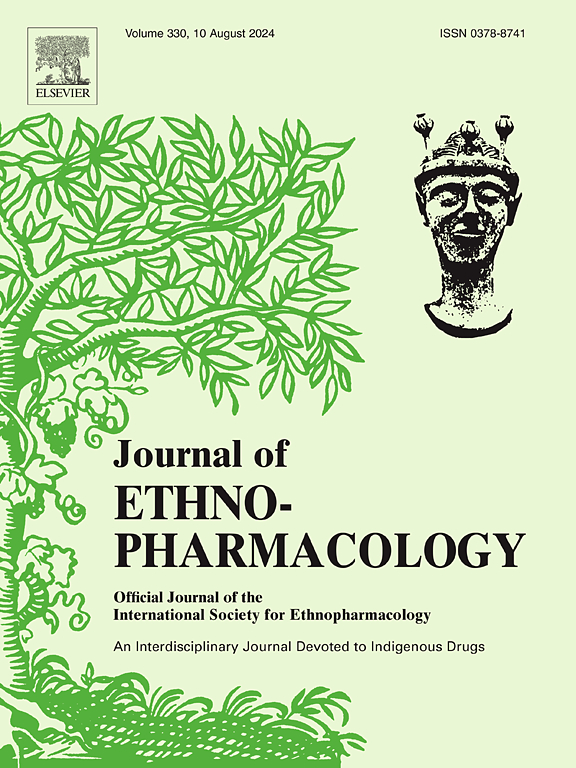Anti-hyperuricemic effects of the seeds of Hovenia acerba in hyperuricemia mice
IF 5.4
2区 医学
Q1 CHEMISTRY, MEDICINAL
引用次数: 0
Abstract
Ethnopharmacological relevance
The seeds of Hovenia acerba water extract (HAW) are used as an edible traditional Chinese medicine to treat diseases related to hyperuricemia (HUA).
Aim of the study
To evaluate HAW for its anti-HUA effect and to figure out their underlying mechanisms.
Materials and methods
The anti-HUA effects were evaluated on a mouse model by testing HAW's effects on the levels of serum uric acid (SUA), the biochemical indicators of liver and kidney function, and the histology of liver and kidney. Body weight and organ coefficients were determined for safety evaluation. RT-qPCR, Western blot and transcriptomic analysis was applied to investigate key mRNAs, proteins and signaling pathways.
Results
HAW significantly reduced the serum levels of UA, ALT, AST, and xanthine oxidase (XOD) and histologically alleviated the liver damage in HUA mice with no negative effect on body weight and organ coefficients. HAW markedly inhibited hepatic XOD activity and protein expression, significantly down-regulated mRNA and protein expressions of urate transporter 1 (URAT1) and glucose transporter 9 (GLUT9), and up-regulated those of ATP transporter G2 (ABCG2) and renal organic anion transporter 1 (OAT1). RNA-seq analysis showed that 248 HUA-induced differential expression genes (DEGs) were reversed by HAW in the kidney. qRT-PCR analysis showed that regulation of the expressions of HUA-related inflammatory genes were involved.
Conclusion
HAW possessed remarkable anti-HUA effect. The mechanism involved XOD inhibition to reduce uric acid production, up-regulation of ABCG2 and OAT1 to increase uric acid excretion, and down-regulation of GLUT9 and URAT1 to inhibit uric acid reabsorption, and regulation of HUA-related inflammatory genes.

苦参种子对高尿酸血症小鼠的抗高尿酸作用。
民族药理学相关性:苦楝水提取物(HAW)的种子被用作一种可食用的中药来治疗与高尿酸血症(HUA)相关的疾病。目的:评价HAW的抗hua作用,探讨其作用机制。材料与方法:通过对小鼠血清尿酸(SUA)水平、肝肾功能生化指标及肝肾组织学指标的影响,评价其抗hua作用。测定体重和器官系数进行安全性评价。应用RT-qPCR、Western blot和转录组学分析对关键mrna、蛋白和信号通路进行研究。结果:HAW显著降低HUA小鼠血清UA、ALT、AST和黄嘌呤氧化酶(XOD)水平,在组织学上减轻了HUA小鼠的肝损伤,对体重和脏器系数无负面影响。HAW显著抑制肝脏XOD活性和蛋白表达,显著下调尿酸转运蛋白1 (URAT1)和葡萄糖转运蛋白9 (GLUT9)的mRNA和蛋白表达,上调ATP转运蛋白G2 (ABCG2)和肾有机阴离子转运蛋白1 (OAT1)的mRNA和蛋白表达。RNA-seq分析显示,肾中248个hua诱导的差异表达基因(DEGs)被HAW逆转。qRT-PCR分析显示,hua相关炎症基因的表达受到调控。结论:黄芪多糖具有明显的抗hua作用。其机制包括抑制XOD减少尿酸生成,上调ABCG2和OAT1增加尿酸排泄,下调GLUT9和URAT1抑制尿酸重吸收,以及调节hua相关炎症基因。
本文章由计算机程序翻译,如有差异,请以英文原文为准。
求助全文
约1分钟内获得全文
求助全文
来源期刊

Journal of ethnopharmacology
医学-全科医学与补充医学
CiteScore
10.30
自引率
5.60%
发文量
967
审稿时长
77 days
期刊介绍:
The Journal of Ethnopharmacology is dedicated to the exchange of information and understandings about people''s use of plants, fungi, animals, microorganisms and minerals and their biological and pharmacological effects based on the principles established through international conventions. Early people confronted with illness and disease, discovered a wealth of useful therapeutic agents in the plant and animal kingdoms. The empirical knowledge of these medicinal substances and their toxic potential was passed on by oral tradition and sometimes recorded in herbals and other texts on materia medica. Many valuable drugs of today (e.g., atropine, ephedrine, tubocurarine, digoxin, reserpine) came into use through the study of indigenous remedies. Chemists continue to use plant-derived drugs (e.g., morphine, taxol, physostigmine, quinidine, emetine) as prototypes in their attempts to develop more effective and less toxic medicinals.
文献相关原料
公司名称
产品信息
索莱宝
Potassium oxonate (PO)
索莱宝
Benzbromarone (BEN)
索莱宝
hypoxanthine (HX)
索莱宝
Potassium oxonate (PO)
索莱宝
Benzbromarone (BEN)
 求助内容:
求助内容: 应助结果提醒方式:
应助结果提醒方式:


